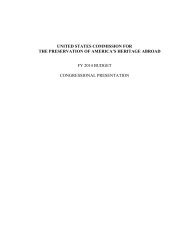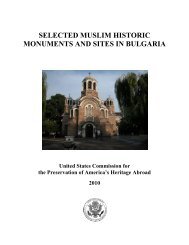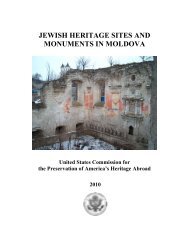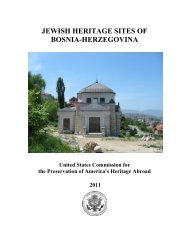jewish cemeteries, synagogues, and mass grave sites in ukraine
jewish cemeteries, synagogues, and mass grave sites in ukraine
jewish cemeteries, synagogues, and mass grave sites in ukraine
You also want an ePaper? Increase the reach of your titles
YUMPU automatically turns print PDFs into web optimized ePapers that Google loves.
III.4 (b)<br />
Types of Gravestones <strong>and</strong> Other Cemetery Features<br />
Historic Jewish tombstones are conspicuous <strong>in</strong> decoration <strong>and</strong> symbols. The decoration (simple<br />
plant motifs <strong>and</strong> other decorative elements) has developed s<strong>in</strong>ce the Middle Ages. It has been<br />
<strong>in</strong>fluenced by the various styles <strong>in</strong> art, often reflect<strong>in</strong>g different regional <strong>and</strong> local characteristics,<br />
the tradition of <strong>in</strong>dividual stone-cutters, <strong>and</strong> the type of stone used. Relief images, situated <strong>in</strong> the<br />
upper part of the <strong>grave</strong>stone, are often symbols describ<strong>in</strong>g the descendants of a specific, ancient<br />
Hebrew family or tribe. Symbols of a trade or profession or animals denot<strong>in</strong>g family names are<br />
also used.<br />
Monuments, depend<strong>in</strong>g of the date of burial, were decorated by bas-reliefs <strong>and</strong> texts of embossed<br />
or cutout letters. Images <strong>and</strong> texts on the monuments were often pa<strong>in</strong>ted <strong>in</strong> colors, as many as<br />
five on one monument. Each region had its own artistic traditions that reflected folk, symbolic,<br />
<strong>and</strong> religious traditions of local Jewish communities.<br />
The <strong>in</strong>scriptions on the <strong>grave</strong>stones (epigraphs) were <strong>in</strong> Hebrew from the Middle Ages through<br />
the 19 th century, but by the mid-19 th century bil<strong>in</strong>gual <strong>in</strong>scriptions – Hebrew <strong>and</strong> German –<br />
began to appear. Yiddish <strong>and</strong> Russian <strong>in</strong>scriptions soon followed. Depend<strong>in</strong>g on the area of<br />
Ukra<strong>in</strong>e, some 20 th century <strong>grave</strong>stones have <strong>in</strong>scriptions <strong>in</strong> German or Russian only, with<br />
abbreviations of traditional Hebrew formulae. Purely Hebrew <strong>in</strong>scriptions, however, are still<br />
used on tombstones of Orthodox Jews.<br />
Because it takes a long time to carve a tombstone, Jewish law dictates that a year should pass<br />
before a stone is put <strong>in</strong> place. This also creates a specific period dur<strong>in</strong>g which mourn<strong>in</strong>g is<br />
deemed appropriate. When referr<strong>in</strong>g then, for example, to “a tombstone from 1770” we mean a<br />
tombstone dated 1770 (i.e., the date of death) but completed <strong>and</strong> erected <strong>in</strong> the cemetery most<br />
probably the follow<strong>in</strong>g year, 1771.<br />
Polonne (Khmelnytska oblast) was an acclaimed center of Hasidic learn<strong>in</strong>g between the 17 th <strong>and</strong><br />
19 th centuries, though only two Jewish families live there now. The town had, for <strong>in</strong>stance, the<br />
first Hasidic publish<strong>in</strong>g house <strong>in</strong> Eastern Europe. The old cemetery <strong>in</strong> Polonne still has thirty<br />
18 th century <strong>grave</strong>stones, some dat<strong>in</strong>g from as early as 1727 <strong>and</strong> 1730. These tombstones have<br />
f<strong>in</strong>ely carved borders with animal, floral, <strong>and</strong> architectural motifs. The block script resembles<br />
the pr<strong>in</strong>t<strong>in</strong>g styles of the same period. 37<br />
Some villages, especially <strong>in</strong> the Transcarpathian region (Zakarpatska oblast), would ma<strong>in</strong>ta<strong>in</strong><br />
two Jewish <strong>cemeteries</strong>: one for the Reform rite Jews (the so-called Neolog rite), the other for<br />
Orthodox Jews.<br />
37 In addition to the works of David Goberman, already mentioned, there are several studies of Jewish <strong>grave</strong>stones<br />
that illustrate the range of epigraphic techniques <strong>and</strong> symbolic elements employed on traditional Eastern European<br />
<strong>grave</strong>stones of the type found throughout much of Ukra<strong>in</strong>e. See: Department of Art History, Hebrew University of<br />
Jerusalem, Revival: Rubb<strong>in</strong>gs of Jewish Gravestones from the Ukra<strong>in</strong>e (Jerusalem: Hebrew University of Jerusalem,<br />
1992); Petr Ehl, Arno Parik <strong>and</strong> Jiri Fiedler, Old Bohemian <strong>and</strong> Moravian Cemeteries. (Prague: Paseka, 1991); <strong>and</strong><br />
Monika Krajewska, A Tribe of Stones: Jewish Cemeteries <strong>in</strong> Pol<strong>and</strong> (Warsaw: Polish Scientific Publishers, 1993).<br />
34









